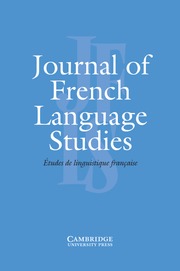The author would like to note several errors present in the published manuscript.
-
Discussion with colleagues revealed that the word ‘méchant’ is not used as an intensifier in Lyon, nor in other parts of France, contrary to what is suggested by Krištofíková (2012). As a result, its inclusion on pages 6 and 13 of the present article, alongside other well-attested intensifiers such as grave and cher, was misinformed.
-
On page 23, the following section mistakenly presents the statistical results for speaker age instead of gender: “Statistically, results from the first mixed- effects regression model show speaker age to not be a significant predictor of intensifier rate, neither as an individual predictor (β = −0.0276, SE = 0.266, p = 0.790), nor in interaction with other fixed effects (see Appendix A; Table A1).”
This section should read as follows: “Statistically, results from the first mixed-effects regression model show speaker gender to not be a significant predictor of intensifier rate, neither as an individual predictor ( β = −0.2086, SE = 0.1525, p = 0.171), nor in interaction with other fixed effects (see Appendix A; Table A1).”
Revised versions of two figures in this article (Figures 9 and 10) are presented and discussed below.
-
In the original version of Figure 9, correlation coefficients were erroneously calculated based on each individual token of très in the data. This resulted in the correlation between the percentile use of très and speaker age showing a significant p-value in the ESLO1 sample, despite an observable and numerically weak correlation being found between these variables in this sample. When each participant’s mean percentile use of très is plotted as a single measure, as shown in the revised version of Figure 9 below, this effect disappears (p = 0.281).

Figure 9. Percentage of très use out of total number of intensifiers by speaker age and corpus.
These results show the same numerical trends as what is reported in the following section of the article: “Figure 9 shows a significant positive correlation between ESLO2 speakers’ proportional use of très and their age (R = 0.48, p<0.001), whereas the correlation coefficient for the ESLO1 reveals a very weak magnitude of associate between these factors (R = 0.12).”
Nonetheless, based on the revised figure, this section should read as follows:
“Figure 9 shows a significant positive correlation between ESLO2 speakers’ proportional use of très and their age (R = 0.58, p = 0.007), whereas the correlation coefficient for the ESLO1 reveals a non-significant association between these factors (R = –0.27, p = 0.281).”
-
Similarly, the correlation coefficients displayed in Figure 10 of the article reflect the correlational trends between age and each individual token of intensifiers super, tout, vachement, and vraiment. This explains why, in the original text, the latter three intensifiers were found to have significant p-values of less than 0.05 despite showing weak correlations between percentile use and speaker age. The corrected statistical results are shown below in a revised version of Figure 10.

Figure 10. Percentage of individual ESLO2 speakers’ use of super, tout, vachement, and vraiment (as a percentage of total intensifiers used) by speaker age.
Correspondingly, the correlation coefficients reported in the following section on page 25 do not reflect what is found in the revised version of Figure 10: “Correlation coefficients from these plots show a strong negative correlation between proportional use of super and speaker age (R = −0.76), and weak negative correlations for tout (R=−0.11) and vraiment (R=−0.2). Conversely, a weak positive correlation is found between the use of vachement and speaker age (R = 0.22), although this may be due to the fact that relatively few speakers used this intensifier compared to super, tout, and vraiment.”
This section should read as follows:
“Correlation coefficients from these plots show a statistically significant, strong negative correlation between proportional use of super and speaker age (R = −0.71, p = 0.023) and a weaker negative correlation for vraiment (R = −0.33). Conversely, no observable correlations are found between proportional intensifier use and age for tout or vachement .”
All other figures in the article display the data as originally intended upon publication of this article. However, alternative versions of these figures, with updated stylistic changes, are provided below. These figures have a higher resolution than those printed in the article, should readers wish to reproduce or adapt them in their own work.

Figure 1. Comparison of intensification rates across intensifier studies (Ito and Tagliamonte, 2003; Tagliamonte and Roberts, 2005; Tagliamonte, 2008; Stratton, 2020; Stratton and Sundquist, 2022). On the ‘Hexagonal French’ bar, the pink portion shows the intensification rate for only amplifiers, while the pink and red portion together show the intensification rate for both amplifiers and downtoners.

Figure 2. Percentage differentials of ESLO intensifiers between 1969–1970 and 2010.

Figure 3. Change in adjectival function for the eight most frequent intensifiers in the ESLO sample.

Figure 4. Correlation between change in proportional frequency and change in adjectival function for frequent ESLO intensifiers.

Figure 5. Collocational width of intensifiers (operationalized through type-token ratios) in the ESLO1 and ESLO2 samples. Higher values on the x-axis indicate more lexical diversity. Intensifiers are organized from left to right in order of increasing overall lexical diversity.

Figure 6. Scatterplot showing correlation between change in frequency of use and collocational width (as a function of the type-token ratio) for individual intensifiers.

Figure 7. Percentage of intensified adjectives by speaker gender and corpus. Error bars show the standard deviation for each group.

Figure 8. Intensification rate by speaker age in the ESLO1 and ESLO2.













